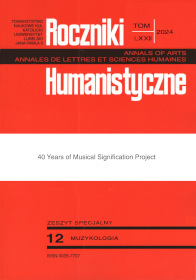The Role of Texture in the Expression of Musical Emotion: The Menuet from Bach’s Partita no. 4 in D Major, BWV 828
The Role of Texture in the Expression of Musical Emotion: The Menuet from Bach’s Partita no. 4 in D Major, BWV 828
Author(s): Robert S. HattenSubject(s): Fine Arts / Performing Arts, Music
Published by: Towarzystwo Naukowe KUL & Katolicki Uniwersytet Lubelski Jana Pawła II
Keywords: Bach; musical texture; developing variation; topics; emotion
Summary/Abstract: Musical texture is a complex sign based on the functional interrelationship of all the “voices” in a given segment of music. In Bach’s era, textural categories were oppositionally conceived as primarily homophonic (block-chordal, or melody with chordal accompaniment) vs. polyphonic (linear-contrapuntal, often imitative). However, the Partitas, comprising the third and most compositionally advanced collection of his keyboard suites, exhibit an unusual variety of textures, both shifts among textures and imaginative blends of textural types. Since earlier suite dances are typically based on a single texture, Bach’s textural play suggests a deeper expressive motivation. I demonstrate how, in the Menuet from the Partita, Bach pioneers both textural contrast within phrases and an ongoing developing variation of texture to create a more highly nuanced expressive trajectory.
Journal: Roczniki Humanistyczne
- Issue Year: 72/2024
- Issue No: 12S
- Page Range: 153-160
- Page Count: 8
- Language: English

